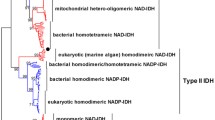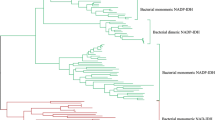Abstract
The gene encoding isocitrate dehydrogenase (IDH) of Methylococcus capsulatus (McIDH) was cloned and overexpressed in Escherichia coli. The purified enzyme was NAD+-dependent with a thermal optimum for activity at 55–60°C and an apparent midpoint melting temperature (T m) of 70°C. Analytical ultracentrifugation (AUC) revealed a homotetrameric state, and McIDH thus represents the first homotetrameric NAD+-dependent IDH that has been characterized. Based on a structural alignment of McIDH and homotetrameric homoisocitrate dehydrogenase (HDH) from Thermus thermophilus (TtHDH), we identified the clasp-like domain of McIDH as a likely site for tetramerization. McIDH showed moreover, higher sequence identity (48%) to TtHDH than to previously characterized IDHs. Putative NAD+-IDHs with high sequence identity (48–57%) to McIDH were however identified in a variety of bacteria showing that NAD+-dependent IDHs are indeed widespread within the domain, Bacteria. Phylogenetic analysis including these new sequences revealed a close relationship with eukaryal allosterically regulated NAD+-IDH and the subfamily III of IDH was redefined to include bacterial NAD+- and NADP+-dependent IDHs. This apparent relationship suggests that the mitochondrial genes encoding NAD+-IDH are derived from the McIDH-like IDHs.




Similar content being viewed by others
References
Aoshima M, Oshima T (1997) Purification and characterization of isocitrate dehydrogenase from a hyperthermophilic archaebacterium, Caldococcus noboribetus. Biochim Biophys Acta 1340:227–234
Bradford MM (1976) A rapid and sensitive method for the quantification of microgram quantities of protein utilizing the principle of protein-dye binding. Anal Biochem 7:248–254
Camacho ML, Brown RA, Bonete MJ, Danson MJ, Hough DW (1995) Isocitrate dehydrogenases from Haloferax volcanii and Sulfolobus solfataricus—enzyme-purification, characterization and N-terminal sequence. FEMS Microbiol Lett 134:85–90
Ceccarelli C, Grodsky NB, Ariyaratne N, Colman RF, Bahnson BJ (2002) Crystal structure of porcine mitochondrial NADP(+)-dependent isocitrate dehydrogenase complexed with Mn2+ and isocitrate—insights into the enzyme mechanism. J Biol Chem 277:43454–43462
Chen RD, Greer A, Dean AM (1995) A highly active decarboxylating dehydrogenase with rationally inverted coenzyme specificity. Proc Natl Acad Sci USA 92:11666–11670
Chen RD, Greer A, Dean AM (1996) Redesigning secondary structure to invert coenzyme specificity in isopropylmalate dehydrogenase. Proc Natl Acad Sci USA 93:12171–12176
Chen RD, Greer AF, Dean AM (1997) Structural constraints in protein engineering—the coenzyme specificity of Escherichia coli isocitrate dehydrogenase. Eur J Biochem 250:578–582
Chen RD, Jeong SS (2000) Functional prediction: identification of protein orthologs and paralogs. Protein Sci 9:2344–2353
Dean AM, Golding GB (1997) Protein engineering reveals ancient adaptive replacements in isocitrate dehydrogenase. Proc Natl Acad Sci USA 94:3104–3109
Eikmanns BJ, Rittmann D, Sahm H (1995) Cloning, sequence analysis, expression, and inactivation of the Corynebacterium glutamicum Icd gene encoding isocitrate dehydrogenase and biochemical characterization of the enzyme. J Bacteriol 177:774–782
Eisenthal R, Cornish-Bowden A (1974) Direct linear plot—new graphical procedure for estimating enzyme kinetic-parameters. Biochem J 139:715–720
Fukunaga N, Imagawa S, Sahara T, Ishii A, Suzuki M (1992) Purification and characterization of monomeric isocitrate dehydrogenase with NADP+-specificity from Vibrio parahaemolyticus Y-4. J Biochem (Tokyo) 112:849–855
Galvez S, Gadal P (1995) On the function of the NADP-dependent isocitrate dehydrogenase isoenzymes in living organisms. Plant Sci 105:1–14
Gouet P, Courcelle E, Stuart DI, Metoz F (1999) ESPript: analysis of multiple sequence alignments in postscript. Bioinformatics 15:305–308
Gray MW, Doolittle WF (1982) Has the endosymbiont hypothesis been proven? Microbiol Rev 46:1–42
Hurley JH, Thorsness PE, Ramalingam V, Helmers NH, Koshland DE, Stroud RM (1989) Structure of a bacterial enzyme regulated by phosphorylation, isocitrate dehydrogenase. Proc Natl Acad Sci USA 86:8635–8639
Imada K, Sato M, Tanaka N, Katsube Y, Matsuura Y, Oshima T (1991) 3-Dimensional structure of a highly thermostable enzyme, 3-isopropylmalate dehydrogenase of Thermus thermophilus at 2.2 Å resolution. J Mol Biol 222:725–738
Imada K, Inagaki K, Matsunami H, Kawaguchi H, Tanaka H, Tanaka N, Namba K (1998) Structure of 3-isopropylmalate dehydrogenase in complex with 3-isopropylmalate at 2.0 angstrom resolution: the role of Glu88 in the unique substrate-recognition mechanism. Structure 6:971–982
Inoue H, Tamura T, Ehara N, Nishito A, Nakayama Y, Maekawa M, Imada K, Tanaka H, Inagaki K (2002) Biochemical and molecular characterization of the NAD+-dependent isocitrate dehydrogenase from the chemolithotroph Acidithiobacillus thiooxidans. FEMS Microbiol Lett 214:127–132
Kanao T, Kawamura M, Fukui T, Atomi H, Imanaka T (2002) Characterization of isocitrate dehydrogenase from the green sulfur bacterium Chlorobium limicola—a carbon dioxide-fixing enzyme in the reductive tricarboxylic acid cycle. Eur J Biochem 269:1926–1931
Karlström M, Stokke R, Steen IH, Birkeland NK, Ladenstein R (2005) Isocitrate dehydrogenase from the hyperthermophile Aeropyrum pernix: X-ray structure analysis of a ternary enzyme-substrate complex and thermal stability. J Mol Biol 345:559–577
Karlström M, Steen IH, Madern D, Fedøy AE, Birkeland NK, Ladenstein R (2006) The crystal structure of a hyperthermostable subfamily II isocitrate dehydrogenase from Thermotoga maritima. Febs J 273:2851–2868
Lancien M, Gadal P, Hodges M (1998) Molecular characterization of higher plant NAD-dependent isocitrate dehydrogenase: evidence for a heteromeric structure by the complementation of yeast mutants. Plant J 16:325–333
Lloyd AJ, Weitzman PDJ (1988) Purification and characterization of NAD-linked isocitrate dehydrogenase from Methylophilus methylotrophus. Biochem Soc Trans 16:871–872
Maki S, Yoneta M, Takada Y (2006) Two isocitrate dehydrogenases from a psychrophilic bacterium, Colwellia psychrerythraea. Extremophiles 10:237–249
Miyazaki J, Asada K, Fushinobu S, Kuzuyama T, Nishiyama M (2005) Crystal structure of tetrameric homoisocitrate dehydrogenase from an extreme thermophile, Thermus thermophilus: involvement of hydrophobic dimer–dimer interaction in extremely high thermotolerance. J Bacteriol 187:6779–6788
Miyazaki K, Kakinuma K, Terasawa H, Oshima T (1993) Kinetic-analysis on the substrate-specificity of 3-isopropylmalate dehydrogenase. FEBS Lett 332:35–36
Miyazaki K (1996) Isocitrate dehydrogenase from Thermus aquaticus YT1: Purification of the enzyme and cloning, sequencing, and expression of the gene. Appl Environ Microbiol 62:4627–4631
Miyazaki K (2005a) Bifunctional isocitrate-homoisocitrate dehydrogenase: a missing link in the evolution of beta-decarboxylating dehydrogenase. Biochem Biophys Res Commun 331:341–346
Miyazaki K (2005b) Identification of a novel trifunctional homoisocitrate dehydrogenase and modulation of the broad substrate specificity through site-directed mutagenesis. Biochem Biophys Res Commun 336:596–602
Muro-Pastor MI, Florencio FJ (1994) NADP+-isocitrate dehydrogenase from the cyanobacterium Anabaena sp. strain PCC 7120: purification and characterization of the enzyme and cloning, sequencing, and disruption of the Icd Gene. J Bacteriol 176:2718–2726
Schuck P (2000) Size-distribution analysis of macromolecules by sedimentation velocity ultracentrifugation and Lamm equation modeling. Biophys J 78:1606–1619
Singh SK, Miller SP, Matsuno K, Sonenshein AL, LaPorte DC, Banaszak LJ (1999) Crystal structure of isocitrate dehydrogenase from B. subtilis. FASEB J 13:A1560–A1560
Singh SK, Miller SP, Dean A, Banaszak LJ, LaPorte DC (2002) Bacillus subtilis isocitrate dehydrogenase—a substrate analogue for Escherichia coli isocitrate dehydrogenase kinase/phosphatase. J Biol Chem 277:7567–7573
Steen IH, Madsen MS, Birkeland NK, Lien T (1998) Purification and characterization of a monomeric isocitrate dehydrogenase from the sulfate-reducing bacterium Desulfobacter vibrioformis and demonstration of the presence of a monomeric enzyme in other bacteria. FEMS Microbiol Lett 160:75–79
Steen IH, Madern D, Karlström M, Lien T, Ladenstein R, Birkeland NK (2001) Comparison of isocitrate dehydrogenase from three hyperthermophiles reveals differences in thermostability, cofactor specificity, oligomeric state, and phylogenetic affiliation. J Biol Chem 276:43924–43931
Suzuki T, Inoki Y, Yamagishi A, Iwasaki T, Wakagi T, Oshima T (1997) Molecular and phylogenetic characterization of isopropylmalate dehydrogenase of a thermoacidophilic archaeon, Sulfolobus sp. strain 7. J Bacteriol 179:1174–1179
Thompson JD, Gibson TJ, Plewniak F, Jeanmougin F, Higgins DG (1997) The CLUSTAL_X windows interface: flexible strategies for multiple sequence alignment aided by quality analysis tools. Nucleic Acids Res 25:4876–4882
Timmis JN, Ayliffe MA, Huang CY, Martin W (2004) Endosymbiotic gene transfer: organelle genomes forge eukaryotic chromosomes. Nat Rev Genet 5:123–135
Tipton PA, Beecher BS (1994) Tartrate dehydrogenase, a new member of the family of metal-dependent decarboxylating R-hydroxyacid dehydrogenases. Arch Biochem Biophys 313:15–21
Vieille C, Zeikus GJ (2001) Hyperthermophilic enzymes: sources, uses, and molecular mechanisms for thermostability. Microbiol Mol Biol Rev 65:1–43
Wallon G, Kryger G, Lovett ST, Oshima T, Ringe D, Petsko GA (1997) Crystal structures of Escherichia coli and Salmonella typhimurium 3-isopropylmalate dehydrogenase and comparison with their thermophilic counterpart from Thermus thermophilus. J Mol Biol 266:1016–1031
Ward N, Larsen O, Sakwa J, Bruseth L, Khouri H, Durkin AS, Dimitrov G, Jiang LX, Scanlan D, Kang KH, Lewis M, Nelson KE, Methe B, Wu M, Heidelberg JF, Paulsen IT, Fouts D, Ravel J, Tettelin H, Ren QH, Read T, DeBoy RT, Seshadri R, Salzberg SL, Jensen HB, Birkeland NK, Nelson WC, Dodson RJ, Grindhaug SH, Holt I, Eidhammer I, Jonasen I, Vanaken S, Utterback T, Feldblyum TV, Fraser CM, Lillehaug JR, Eisen JA (2004) Genomic insights into methanotrophy: the complete genome sequence of Methylococcus capsulatus (Bath). Plos Biol 2:1616–1628
Xu X, Zhao JY, Xu Z, Peng BZ, Huang QH, Arnold E, Ding JP (2004) Structures of human cytosolic NADP-dependent isocitrate dehydrogenase reveal a novel self-regulatory mechanism of activity. J Biol Chem 279:33946–33957
Zhang T, Koshland DE (1995) Modeling substrate binding in Thermus thermophilus isopropylmalate dehydrogenase. Protein Sci 4:84–92
Acknowledgments
This work was supported by the Norwegian Research Council (Project no. 153774/420). The Norwegian Structural Biology Centre (NORSTRUCT) is supported by the national Functional Genomics Programme (FUGE) of the Research Council of Norway. We are grateful to Dr. Aurora Martinez, Department of Biomedicine, University of Bergen, for access to her laboratory facilities and expertise in the use of differential scanning calorimetry. The excellent laboratory skills of Lisbeth Glærum and Marit Steine Madsen are also much appreciated.
Author information
Authors and Affiliations
Corresponding author
Rights and permissions
About this article
Cite this article
Stokke, R., Madern, D., Fedøy, AE. et al. Biochemical characterization of isocitrate dehydrogenase from Methylococcus capsulatus reveals a unique NAD+-dependent homotetrameric enzyme. Arch Microbiol 187, 361–370 (2007). https://doi.org/10.1007/s00203-006-0200-y
Received:
Revised:
Accepted:
Published:
Issue Date:
DOI: https://doi.org/10.1007/s00203-006-0200-y




